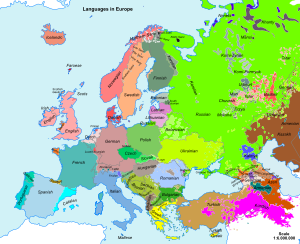
Back لسانيات أوروبا Arabic Eurolinguistik German Eurolinguistique French Eurolinguistica Italian Eurolinguïstiek Dutch Eurolinguistika Albanian Ngôn ngữ học châu Âu Vietnamese
This article has multiple issues. Please help improve it or discuss these issues on the talk page. (Learn how and when to remove these messages)
|

Eurolinguistics is a neologistic term for the study of the languages of Europe. The term Eurolinguistics was first used by Norbert Reiter in 1991 (German equivalent: Eurolinguistik). Apart from a series of works dealing with only a part of the European languages, the work of Harald Haarmann pursues a "pan- or trans-European perspective". This goal is also pursued by Mario Wandruszka.
Typological questions have mainly been dealt with by the Eurolinguistischer Arbeitskreis Mannheim (ELAMA; led by Per Sture Ureland) and the EUROTYP projects. Important sources of linguistic data for Eurolinguistic studies are the Atlas Linguarum Europae (for vocabulary studies) and the World Atlas of Linguistic Structures (Haspelmath et al. 2005, for grammar studies).
The internet platform EuroLinguistiX (ELiX) (edited by Joachim Grzega) offers a bibliography of Eurolinguistic publications as well as a wiki, a discussion forum, an academic internet journal in order to address also aspects of "linguistic and cultural history", "sociology of languages", "language politics" and "intercultural communication". In 2006, Joachim Grzega published a basic reader on common features of European languages.
Also joint with the ELAMA, the EuroLSJ project by Erhard Steller tries to collect essential results of Eurolinguistics and make them usable for everyday life in Europe by transforming them into a representative standard language (LSJ European / Europé LSJ) which wants to serve as an optimized "acquisition and memory helper" (Giuseppe G. Castorina) for a quicker and easier access to all languages of Europe.